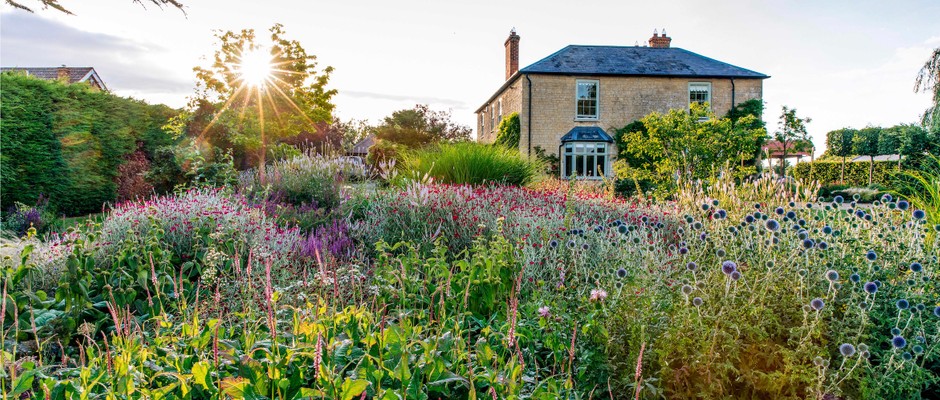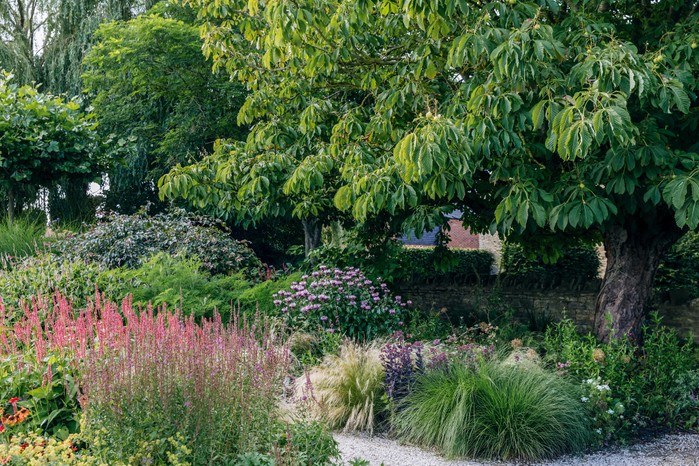
How to create a flower-filled hillside garden
In a garden designed by Anoushka Feiler, masses of flowers cascade down a hillside, running riot around hard-landscaped family areas so they are barely visible in summer. Words Kendra Wilson. Photographs Eva Nemeth.
In brief
What Family garden on a hill. Where Buckinghamshire. Size Two acres. Soil Heavy with good drainage. Climate Temperate but windy and exposed. Hardiness zone USDA 9.
Creating a flower-filled garden
The concept
Why do people hire garden designers? A steady hand with hard landscaping is useful, but really, a great garden can make sense of the way you live. This is clear when visiting a place that fires on all cylinders such as the Old Rectory garden in Northamptonshire that Claire and John Clifford saw before enquiring after its young designer, Anoushka Feiler. The Cliffords were living with their two children in a farmhouse overlooking a former field; it was mown once a week but apart from a couple of flowerbeds near the house their outdoor space was otherwise ignored. The design brief was: “A, to draw us outside and B, to make sure that we’d use the whole area, rather than just the top bit of the garden.”

Claire enjoyed gardening but needed the help of a professional to realise the potential of her two acres. Anoushka began by considering the wider landscape and its loose grid of fields (there is a working farm over the hedge) and this led her to thinking about the local town, Milton Keynes, and its more rigid street grid. Halfway down the garden’s long, sloping garden, her team levelled out a flat playing field below a generously planted flower garden. Below that, Anoushka experimented with more perennials, joined by grasses and planted in squares: “Just like Milton Keynes.”
Inspirations
The genius of the 1960s new town is evident in many ways. Young trees planted five decades ago have matured, and the town’s former gravel pits are now a series of lakes and a nature reserve. Obscuring human intervention, the tree canopies are a reminder, not unpleasant, that the centre of town is only ten minutes away. Considering how best to incorporate the family elements of the garden (places to eat, and trampoline), Anoushka drew on the wilding of the town’s surroundings, with a view to making the hard landscaping disappear in a luxuriance of plants. “Often you start with the areas where people are going to sit, and you fit in the flowery planting around it. I do the opposite.”

Leisure spots are scattered through the planting in ovals and circles as the garden descends from the house. The only area that is clearly marked is the first, signalled by a quartet of roof-trained Platanus x hispanica, making a green canopy over a hidden dining terrace in summer. This is a garden that flows: sturdy perennials, chosen for their form and texture, are grouped into waves of colour. Pinks and purples, including Achillea millefolium ‘Cerise Queen’ and Monarda ‘Blaustrumpf’ merge into oranges and reds (Helenium ‘Moerheim Beauty’ and Persicaria amplexicaulis Orange Field (= ‘Orangofield’) before being intercepted by a band of whites and yellows (Echinacea purpurea ‘White Swan’ and Rudbeckia fulgida var. sullivantii ‘Goldsturm’) with Alchemilla mollis to aid movement. “I like keeping the colours together,” says Anoushka. “And having wider bursts that go next to each other.”
More like this

Further down the slope, where the planting becomes more grassy and modular, the flowing continues. This is partly thanks to the behaviour of perennials that share moderate requirements regarding moisture, drainage and sun. After a storm or high winds, grasses such as Calamagrostis x acutiflora ‘Karl Foerster’ and Panicum virgatum ‘Cloud Nine’ may need staking, but generally there is safety in numbers. And the numbers are fairly vast, with many hundreds of pots of grasses going into the first planting in this area, joined by masses of perennials, with bulkier items including Eupatorium maculatum ‘Riesenschirm’ next to a square of Melica altissima ‘Alba’, and Persicaria amplexicaulis ‘Rosea’ with Miscanthus sinensis ‘Malepartus’. Over the past four years, Claire has added thousands of tulip bulbs every winter to join the many alliums.
Creating self-sufficiency
Since departing with the advice to allow the planting to mature for the first couple of seasons, Anoushka has not been needed. Instead, Claire has embraced the difficulties of the exposed site, putting in irrigation – after several years of devoting her evenings to watering – and propagating and growing annuals in the greenhouse. Early spring requires bindweed vigilance, with mulching when required. “Once things are established it’s pretty self-sufficient,” says Claire, although there is a quantity of cutting back, particularly of grasses in February and March. She has two half-days of help a week.

A row of white birch trees (Betula utilis subsp. jacqemontii) fringe either side of the lower grass-and-perennial garden, with fields on one side and a road with neighbouring houses on the other. Claire wanted trees that would mitigate the presence of the houses, without blocking the wider views for those neighbours. She is refreshingly philosophical about privacy; with a public footpath running down the side of the garden towards the River Great Ouse, walkers don’t hesitate to share their opinion of the garden. “Someone left a note by the front gate under a stone, which said that they really enjoyed passing the garden and seeing it change through the seasons,” says Claire. “That’s encouraging.”
Showing item 1 of 20








































12 Key Plants
Echinacea purpurea

‘White Swan’ Green to yellow cones with a drooping tutu of white petals; sturdy butterfly and bee attractors on stiff stems. Tough and long-flowering; appreciates moisture. 60cm. RHS H5, USDA 3a-8b†.
Monarda ‘Blaustrumpf’

A mint family member with luminous, purple whorls of tubular, two-lipped flowers, bee balm is highly attractive to pollinators. Needs a moist, well-drained soil. 90cm. RHS H4, USDA 4a-8b.
Persicaria amplexicaulis Orange Field (= ‘Orangofield’)

Its beguiling, coral-pink flower spikes appear over mounds of foliage. From July to October it buzzes with hoverflies and other pollinators. Requires a moist soil. 90cm.
Daucus carota

This wild carrot, sometimes known as Queen Anne’s lace, is a meadow flower with white umbels that increase in beauty as the season goes on, finally reaching upwards like an upside-down petticoat. 60cm. RHS H7.
Penstemon ‘Andenken an Friedrich Hahn’

A richly coloured favourite in this garden. Flowering is prolonged by deadheading. Cut back after the last frosts; easy to propagate. Needs a well-drained soil. 90cm. AGM*. RHS H5.
Veronicastrum virginicum ‘Fascination’

Another tall, easy-going perennial with luminous colour that is highly attractive to bees. Offers a long flowering period, and is happy in sun or semi-shade. Prefers moist but well-drained soil. 1.2m. RHS H7, USDA 3a-8b.
Papaver somniferum

Opium poppy seedheads can be even better than those of the variable wildflowers. Hard, perforated cases protect seeds from wet while dispersing them over a long period. 1.2m. RHS H5.
Echinops bannaticus

The blue globe thistle is intensely interesting to pollinators, with smallish, spherical flowerheads borne over soft spiny leaves. Cut back after flowering to prevent liberal self-seeding. 1.2m. RHS H7, USDA 3a-8b.
Lythrum salicaria ‘Blush’

A selected form of purple loosestrife. Resident of river edges and ponds, it needs some moisture. Produces strong, leafy spires of nectar-rich, bee-friendly, pink flowers. AGM. 80cm. RHS H7.
Eschscholzia californica

Bright-orange California poppy, which happily self-seeds in poor soil and full sun. Attractive, glaucous leaves with fine filigree add lower-storey texture to a dry garden. 30cm. RHS H3, USDA 6a-10b.
Achillea millefolium ‘Cerise Queen’

This hoverfly magnet copes with both exposure and drought, but requires good drainage in winter. Cut back in early spring. Fabulous colour over fern-like foliage. 60cm. RHS H7.
Echinacea purpurea

A long-flowering hardy perennial, this purple coneflower is very drought-tolerant, takes exposure and prefers full sun. A North American native with many cultivars and hybrids to choose from. 1.5m. RHS H5.
*Holds an Award of Garden Merit from the Royal Horticultural Society. †Hardiness ratings given where available.
Useful information
Find out more about Anoushka Feiler’s work at bestique.co.uk.

Niwaki bundle worth £57 when you subscribe
Subscribe to Gardens Illustrated magazine and claim your Niwaki bundle worth £57
*UK only

Container Gardening Special Edition
The Gardens Illustrated Guide to Container Gardening.
In this special edition, discover colourful flower combinations and seasonal planting schemes for pots designed by leading plantspeople, and essential know-how for container gardening success. Just £9.99 inc UK p&pBy entering your details, you are agreeing to our terms and conditions and privacy policy. You can unsubscribe at any time.

Gardens of the Globe
From botanical wonders in Australia to tranquil havens closer to home in Ireland, let this guide help you to discover some of the most glorious gardens around the world
By entering your details, you are agreeing to our terms and conditions and privacy policy. You can unsubscribe at any time.




